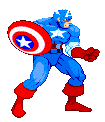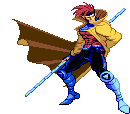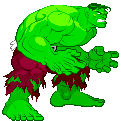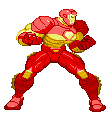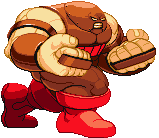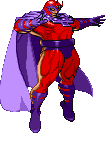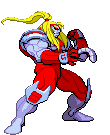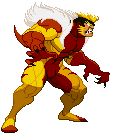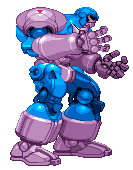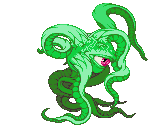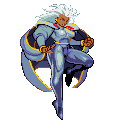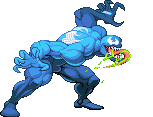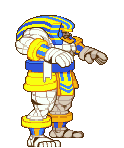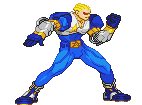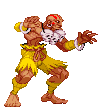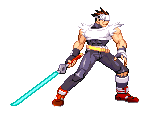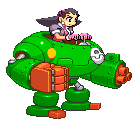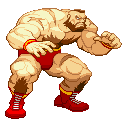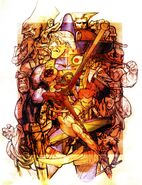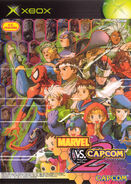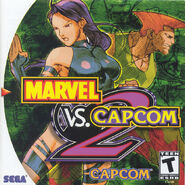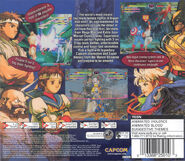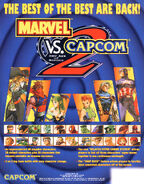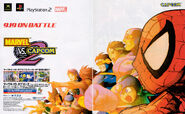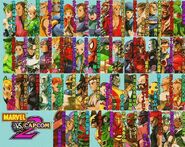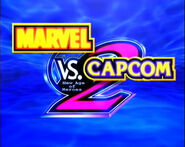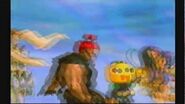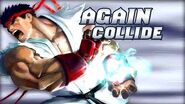Marvel vs. Capcom 2: New Age of Heroes (a.k.a. Marvel vs. Capcom 2 or MvC2) is a 2D fighting game and the fourth installment in the Marvel vs. Capcom series of crossover fighting games featuring characters from Capcom and Marvel Comics.
Capcom simplified the engine so that it would be more accessible to casual players, in order to bring in new players. Changes were made to the air combo system and the button configuration was trimmed down to 4 main buttons and 2 assist buttons. The game also features 3 on 3 tag, compared to the 2 on 2 tag from previous games in the series. It is the only game in the series to use the NAOMI system, which is used mostly for 3D games. It is mainly seen in this game in the backgrounds and system effects, as well as Abyss' sphere. Marvel vs. Capcom 2 was later ported to the Dreamcast, Xbox, PlayStation 2, Xbox Live Arcade and PlayStation Network.
The PlayStation 2 and Xbox ports saw a limited print run due to Capcom losing the Marvel license. While these versions are merely uncommon, high demand has caused their prices to skyrocket both in stores and online. The Dreamcast version is the closest of the three home console ports to the arcade version, due to its hardware being similar to that of a NAOMI, and at the same time it is the cheapest due to a higher number of copies produced.
Gameplay[]
Players select three fighters from the roster of Marvel and Capcom characters and fight one-on-one until one of the teams have no remaining players. Each character has at least one super combo and the entire team shares a single super meter. The characters can draw on this (at a minimum cost of one super meter level) to perform their super combos or other special super moves.
Control is similar to the previous Vs. games, which itself derives from the Street Fighter series, except that the screen is now wider. The major difference is that instead of three punch/kick attack strength, there are only two, with the last two buttons being replaced by assist buttons. Most often, a weak attack can chain two different hits. The second is a medium attack which was featured in the previous games.
The player can also call in an off-screen character to do a selected special move by pressing the corresponding assist button. Each character has three assist types which cause them to execute different special moves (or in some cases, a regular move); this is chosen before the match. The player can call an assist at any time, except during a super jump or when executing special or super moves, and the assist character is vulnerable to attack or even death. The characters receive double damage than normal when attacked during an assist.
Marvel vs. Capcom 2 introduces the ability to force an opponent's teammate into the fight with a move commonly called a "snapback", which requires one super meter to execute. The character will flash for a moment and do a normal attack which will knock the opponent out of the playing field if it's not blocked. If successful, the current character will be knocked out of play and the next available partner will enter the fight on their behalf. If the move connects with both the active and an assist character, it introduces the possibility of the assist character being knocked out without the opponent being able to defend him/her.
The arcade version features an "experience" system which unlocks hidden characters after a certain number of experience points are earned. This system was removed in the console versions in favor of the "Secret Factor" menu, where the player can buy hidden characters, backgrounds, and artworks using points (earned through normal playing).
Story[]
When the Earth and everything on it begins to die, Ruby Heart traces the source to an evil being known as Abyss, the Armor of Erosion. She summons the greatest heroes to her airship to find the being. Ultimately, its source of power is revealed to be a mysterious black metal ball within its center.
The ending suggests that the sphere may be worthless now given the massive crack in it; Ruby holds it in her hand and regards it briefly before throwing it over her back into the water, letting it sink to the bottom. It is not stated if Abyss could return or not.
Although not officially stated by Capcom, the appearance of Ryu's white headband, Ken's ponytail hairstyle and Charlie all point to the game's events possibly taking place sometime during the Alpha storyline. However, the appearance of Alpha-style characters could be attributed to the fact that those series of games were the most recent to be developed prior to MvC2.
Characters[]
The game adds all characters from previous games in the Vs. series, with the exception of Norimaro (a character exclusive to the Japanese version of Marvel Super Heroes vs. Street Fighter) and alternate versions of characters such as U.S. Agent and Lilith-Mode Morrigan. Some, like Doctor Doom, have added moves, while bosses like Thanos are toned down for competitive purposes. Ryu plays akin to his counterpart from X-Men vs. Street Fighter and Marvel Super Heroes vs. Street Fighter, instead of the "Complete Change" Ryu seen in the original Marvel vs. Capcom, since Ken and Akuma are once again part of the selectable roster.
In addition, many new characters were added: Marvel's side now includes Cable, Adamantium-Less Wolverine, and Marrow, while Capcom adds Felicia, Anakaris, and Baby Bonnie Hood from Vampire Savior, Guile from Street Fighter Alpha 3, and 2D fighting game debuts of Hayato (Star Gladiator), Jill Valentine (Resident Evil), Tron Bonne, and Servbot (Mega Man Legends).
Also, several new original characters were added to the Capcom side (Ruby Heart, SonSon — actually the granddaughter of the SonSon from a previous Capcom game — and Amingo), as well as a completely new boss (Abyss). There is a total of 56 characters to choose from.
Exclusive Characters[]
| Sprite | Character | Summary |
|---|---|---|

|
Ruby Heart | Ruby Heart (ルビィハート Rubyi Hāto?) is the lead character of the game. She is a pirate who owns the flying ship that is responsible for carrying the Marvel and Capcom heroes into battle. |
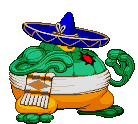
|
Amingo | The only solid information on Amingo (アミンゴ Amingo?) is that he is on a search for a wind that is sweeping across his land and destroying any plant life that it happens to come into contact with. His appearance is that of a round, cactus-like humanoid with a sombrero. He can reshape his entire body into several forms for some of his attacks using a plant theme, and plant smaller, child like versions of himself. He is one of the few characters in the game also to feature a healing assist. |

|
Sonson III | Sonson III (ソンソン Sonson?) is a little monkey girl who is the granddaughter of a character who is also named SonSon, who starred in the 1984 Capcom arcade game SonSon. In the game, she tries to find out why her village was struck by an unknown illness. Sonson and her grandfather are both based on Sun Wukong (孫悟空?), the main character of the classic Chinese novel Journey to the West (西遊記?). Several of her attacks are derived from that series, such as the size-changing bō staff, Wukong's ability to replicate himself using the hairs of his body, or Sonson trying to cook her opponent in the Shinka Hakke Jin and turn them into sake. |
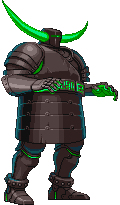
|
Abyss | Abyss (アビス Abisu?) was responsible for a mysterious wind that spread across the world, killing plant life in its wake. This phenomenon prompted numerous heroes and villains to band together and investigate. He's something akin to entropy incarnate, a fabled monstrosity that would bring the world back to primordial times, killing all life in the process.
Abyss' true form is apparently that of a large glowing sphere that hovers around in the background. Abyss changes into three different forms when fighting. In the first stage of the battle, the metal sphere surrounds itself with a giant suit of armor which is slow moving with powerful attacks. The fight takes place in a large temple like structure, presumably underground. After this form is defeated, the armor melts into the floor and the temple crumbles, leaving the fighters standing in a green pool of slime. The abyss sphere floats in the background as the second form reveals itself: a small green humanoid capable of creating paralyzing bubbles, shooting blue fire and energy beams, and sinking into the floor to avoid attacks. After this form is destroyed, the green slime turns orange and a large demonic beast forms around the Abyss sphere. This third form attacks with powerful energy attacks and sheer brute strength. If this form is defeated, the sphere apparently loses its power and the cave and island the monster inhabits begins to sink. |
Marvel vs. Capcom 2 has only one ending, which all the characters share. In it, the various fighters celebrate their victory over Abyss on the ship of the pirate, Ruby Heart Although this varies on which version the player is playing on; the artwork depicts characters that are available from the start, which is different in the arcade version than the console version. At the start of this sequence, Ruby is seen holding Abyss's cracked sphere, which she drops into the ocean, and it sinks into the depths.
Playable characters[]
Boss character[]
| Sprite | Character | Origin |
|---|---|---|

|
Abyss | (original character) |
Trivia[]
- Marvel vs. Capcom 2 has to date the highest number of playable fighters in the series, with a total number of 56 selectable fighters. By comparison, Ultimate Marvel vs. Capcom 3 has 50 selectable fighters (including the two DLC characters).
- This is the first Marvel vs. Capcom game without character-specific endings, as one will get the same end regardless of the characters one uses or how quickly one defeats the final opponent, the second being Marvel vs. Capcom: Infinite.
- Of all of Chun-Li's playable appearances in the Marvel vs. Capcom series, this is the only title in which she is a hidden playable character that must be unlocked.
- There are notable changes of the roster and placements for all ports:
- The Arcade version initially have 28 characters available from the start, which include characters such as Akuma, Morrigan, Gambit and Magneto available for play and 28 secret characters, unlockable via time release or inputting secret passwords in the Test Menu.
- The home ports, particularly the Dreamcast, PS2 and Xbox versions, decreased the default roster from 28 to 24, which increased the amount of secret characters to 32. Because of the console release, Jill Valentine and Tron Bonne were heavily promoted, thus included in the default roster. Sakura, initially a secret character in the arcade version, was also included. The characters mentioned above were also swapped as secret characters and replaced by a few that were in the category in the arcade version (i.e. Psylocke). Surprisingly, this also included Wolverine as his Bone claws version, originally a secret character, swapped his regular adamantium claws version.
- Because certain characters like Jill were now included as default characters in the console versions, some secret characters was swapped in different places, such as M. Bison and Dan.
- The PS3 and Xbox 360 version followed a similar character select screen as the previous home ports, but with some differences: Ryu switched places with Sonson and Wolverine (Adamantium Version) was added back into the default roster, taking Marrow's spot, due to both characters were selectable in the demo version.
Gallery[]
Promotional Art and Packaging[]
Official Art[]
- To view all official character artwork, see: Official Art.
Screenshots[]
Videos[]
External Links[]
- Wikipedia article
- Marvel Database article
- Marvel vs. Capcom wikia article
- Capcom Database article
- Sega Retro article
| Marvel vs. Capcom series | ||||
|---|---|---|---|---|
| X-Men vs. Street Fighter · Marvel Super Heroes vs. Street Fighter · Marvel vs. Capcom: Clash of Super Heroes · Marvel vs. Capcom 2: New Age of Heroes · Marvel vs. Capcom 3: Fate of Two Worlds(Ultimate) · Marvel vs. Capcom Origins · Marvel vs. Capcom Infinite · Marvel vs. Capcom Fighting Collection: Arcade Classics | ||||




